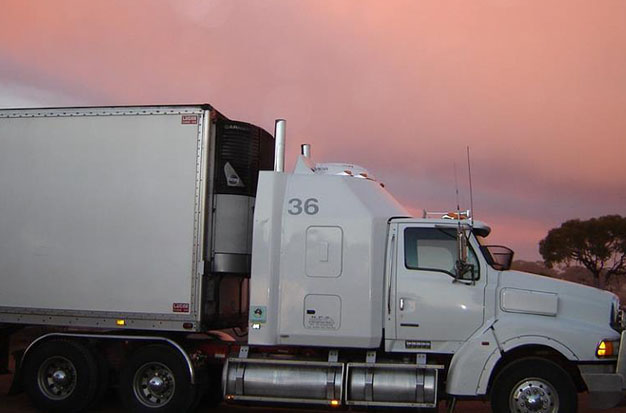I’m going to study reefer trucks today. We’ll examine what they are, how they work, and some advantages or disadvantages. I’ll spend some time delving into those topics as we move along.
Let’s start by talking about what reefers are.
What’s a Reefer Truck?
Refrigerated is slang for “reefer.” The truck is a typical semi-cab. The trailer is basically all that the reefer is, though. So a semi-carrying a refrigerated trailer meant to transport perishable commodities is referred to as a “reefer truck.” Compared to cooling vans, which are only insulated and ventilated, these trailers are different. What distinguishes a reefer trailer? Reefers come with an operational cooling system. As a result, you can carry both frozen and chilled freight.
In order to transport heated commodities, a reefer could also be temperature-controlled. This is considerably less typical, though.
Reefers employ a few different types of cooling techniques. Both cryogenic cooling systems and diesel-powered generators may be seen. Let’s examine the specifics of trailer cooling now.
Parts of a Reefer Truck or Trailer
Active cooling is used rather than passive cooling in reefer trucks and trailers. Instead of depending on insulated panels to preserve a product at a specific temperature for 96 hours or longer, they use battery- or electric-powered generators to keep items at a fixed temperature and humidity.
The compressor, condenser, evaporator, and insulation are among the components of a reefer trailer.
- Compressor: The compressor on a truck unit frequently attaches to the engine and powers the entire unit by bringing in and compressing gaseous refrigerant using a tiny motor or vehicle belt system. The gas is a low-pressure, cool fluid when it enters the system, and it is a high-pressure, hot gas when it leaves.
- Condenser: Following its passage through the compressor, the high-pressure gas travels into condenser coils where it is cooled by fans and loses heat. Once sufficient heat has been absorbed from the cargo section, the condenser uses it to create gas. Due to pressure, the gas inside the condenser condenses and liquidizes, becoming a high-pressure, regular-temperature liquid.
- Expansion valve: The expansion valve controls the flow of refrigerant throughout the system, making it essential to the reefer container truck process. The molecules of the refrigerant expand when the valve restricts the flow, creating a low-pressure, cold liquid.
- Evaporator: The evaporator transforms the cold, low-pressure liquid into a low-temperature, low-pressure gas, and it is situated in the truck’s cargo area. To distribute room-temperature air throughout the trailer, the evaporator fan draws it from the cargo area and passes it through the coils and fins. Due to its low boiling point, the refrigerant passing through the evaporator will boil and transform into a gas. Once the system achieves the desired temperature, the gas goes back to the compressor and restarts the process.
- Insulation: A layer of polyurethane foam throughout the entire trailer protects the truck’s interior from the outside environment.

How Does Refrigerated Trucking Work?
Here is a thorough explanation of how refrigerated trucking operates:
However, let’s first define reefer trucks. Due to their internal vents and insulation, classic semi-trucks known as reefer trucks are specifically made to transport perishable goods and commodities requiring temperature regulation. Cooling vans are fundamentally different from reefer or refrigerated trucks, although having insulation and vents as well. The latter allows for the transportation of frozen and chilled freight thanks to an active cooling system.
Reefer trucks require a tiny diesel engine to power their compressor, which pulls on the gaseous refrigerant and liquefies it as a result. The compressor’s body is then heated by the liquid gas, keeping the truck just moderately warm. This heat exchange procedure takes place in the condenser, much like how radiators cool the engine.
Even after the condenser has removed the majority of the heat from the liquefied gas, it is still under pressure. The pressurized liquid is forced into the evaporator by the condenser, where it cools. The amount of refrigerant that the evaporator receives is managed by a metering valve.
There is always another quickly increasing refrigerant in the evaporator. It absorbs a lot of heat from the surroundings as a result of its expansion, which turns it into a gas. In this manner, the air within the trailer will enter the evaporator before entering the compressor.
Technically, it’s a cycle that keeps repeating itself. As a result of this procedure, the vehicle cools, ensuring that the items being delivered stay chilled. Precoolers are typically used to refrigerate goods inside reefer trucks before shipping to keep them in mint condition.
Advantages of Reefer Trucking
As was already stated, the number of factors determine if a reefer truck is ideal for your company. Nevertheless, in order to make wise business decisions, you should weigh the benefits and drawbacks of reefer transportation. You should be aware of the benefits of reefer trucking listed below:
- Demand and supply for reefer trucks to deliver in-demand fresh goods are consistently strong.
- A great way to shield cargo from the elements, spoilage, potential damage, and theft
- Transport both chilled and temperature-sensitive items, such as medicines. See more about What Is A Straight Truck?
Disadvantages of Reefer Trucking
Despite the fact that reefer trucking could have a few advantages, there are also some potential drawbacks. Here are some of these drawbacks:
- Reefer trucks sometimes make noise
- Increased wait times for loading and unloading on cargo docks
- Accidental product damage
- Not appropriate for long-distance shipping
Things to Consider with Reefer Trucks
As this article has already proven, reefer trucking is a viable option if you frequently need to transport things that are sensitive to temperature. Prior to purchasing or renting a reefer truck, keep the following in mind:
Requirements for Food Safety Training
Reefer trucks need to receive the necessary training in food safety to be used safely and effectively. The ability to maintain the temperatures required for food delivery is the most critical need for a reefer truck.
Transportation of Human and Animal Food to ensure that such items are adequately chilled, conveying trailers and trucks (reefers) are properly sterilized, and other measures to prevent the circulation of dangerous food.
Before selecting such a reefer trailer, you must give the requirements for food safety training first priority. The prerequisites for reefer’s food and safety training are listed below.
- Equipment: The vehicle and every piece of transportation equipment must be thoroughly cleaned and ready for usage. The equipment must also maintain the temperatures required for transporting food safely.
- Operations: This covers the steps taken to assure food safety throughout transportation, such as temperature controls, food contamination prevention, and others. A refrigerated trailer needs often to be “washed out” prior to loading. Any pollution from the prior load is removed in this way.
- Training: For truck drivers covered by the FSMA’s Sanitary Transportation of Human and Animal Food Rule, the FDA provides a training program. This training resource is at no cost.
- Records: Records of contracts, instructions, and written policies must be kept for specific amounts of time, typically at least a year.
Motor Operation
What is the process for the reefer truck? The energy produced by the main engine of the truck is typically used by refrigerated trailers. This means that reefer vehicles’ main engines must continue to operate even while they are not on the road, such as when loading or unloading. Decide whether your organization needs more power for the truck’s refrigerator before purchasing any reefer truck.
Understand the Concepts of Commodity and Temperature Control
Usually, the required temperature depends on the kind of cargo being transported. Therefore, before selecting a reefer truck, you must think about the commodity you intend to convey and the level of temperature control required. Understanding your product also means being aware of the shelf life of each item and the ideal packaging that should be used.
Supervised Loading and Unloading Procedures
To ensure that goods are stored properly and to achieve maximum temperature control, reefer truck drivers are accountable for the loading pattern, location, and weight of their loads. Additionally, unloading must be completed as swiftly and effectively as feasible. Drivers must therefore closely monitor their load to accomplish this.
To make sure that your things are carried and delivered in the finest conditions possible, you should give preference to reefer trucks that provide enough oversight of their loading and unloading procedures.
Unloading and Loading at Night
It’s uncommon to load or unload during the day, partly because the atmosphere is warmer and unsuitable for your items. However, refrigerated trailers only load and unload during the daytime under rigorous monitoring and certain exclusions.
Managing Customers Who Request Specific Unloading
Another important consideration when selecting reefer trucks is how they respond to specific unloading demands. Certain customers or grocery stores frequently request that their freight be broken up or placed in particular ways, which can be annoying or take more time. Therefore, before selecting reefer trucks to serve your clients, you must take into account how they respond to such requests.
Unpaid Waiting Time
The majority of the time, waiting for a load is unpaid. For instance, a grocery shop using reefer transportation might need to store fresh vegetables or other perishables while still rotating its current inventory. The majority of the time, this delay is unpaid.
FAQ:
Why Is a Refrigerated Truck Called a Reefer?
Reefer is the name given to refrigerated vehicles due to the cooling system that is included in their construction. A reefer truck’s temperature can also be changed, allowing it to transport hot cargo.
What Is an Air Chute in a Reefer Trailer and Why Does It Matter?
An air chute in a reefer trailer is a flexible air duct that runs along the top of the trailer and is typically attached to the refrigeration unit. Reefer trailers’ ventilation systems, which consist of air chutes, make sure that cooled air is distributed uniformly throughout the vehicle.
How Long Does a Reefer Trailer Last?
Technically, a reefer trailer’s lifespan depends on the reefer itself, hence there is no definitive answer to this. However, reefers only last an average of 40,000 hours, or around 8 years, before being considered “aged.”
